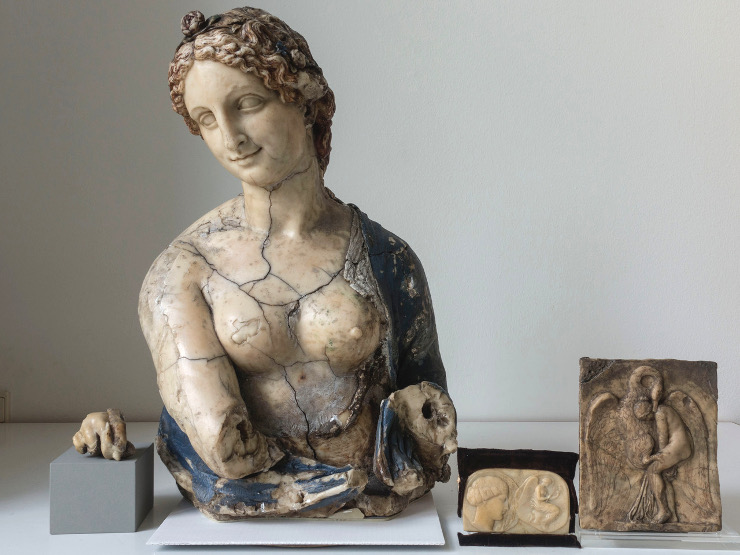Many works of art have been attributed to Leonardo da Vinci (1452-1519), the great artist, scientist and engineer of the Italian Renaissance. However, art historians sometimes have the greatest difficulty in proving this link. This is the case of the wax bust of Flora, kept in the Bode Museum in Berlin, whose face resembles portraits of the Italian painter.
In 1909, the Prussian Wilhelm von Bode found the wax bust of Flora in a London gallery and acquired it for the Berlin museum, convinced that it was a sculpture by Leonardo da Vinci. By 1910, doubts were creeping in. The son of the English sculptor Richard Cockle Lucas declared that his father had made this sculpture in 1846 from a drawing and specified that the statue, which was hollow, had been filled in. After verification, the statue does contain paper and wooden objects dating from the 19th century. But the curators of the Berlin museum persist in attributing the bust to Leonardo da Vinci.
A delicate carbon-14 dating
In the bust wax , chemists observed the presence of spermaceti, a white substance found in the head of certain cetaceans such as sperm whales. This material was rare in the Renaissance but common in the 19th century, when it was used to make candles and to create sculptures from drawings or paintings.
However, spermaceti cannot be dated by carbon 14 (14C) measurement as simply as a terrestrial plant or animal extract. Indeed, a sperm whale is not directly exposed to the (radioactive) carbon 14 contained in the atmosphere but to that contained in the ocean, which is much older. The oceanic 14C has indeed "traveled" more or less long, from its production in the upper atmosphere to the underwater habitat of a cetacean. A correction must therefore be made to calibratethe 14C ages of spermaceti. A correction that varies greatly from one oceanic region to another...
The Flora wax also contains many other ingredients, including beeswax. It is therefore necessary to differentiate the calibration of the carbon 14 measurements according to the terrestrial or marine nature of the organic matter that composes it!
Leda and the swan: Same material...
The scientists carried out in-depth analyses of the wax of Flora's bust, both on the surface and inside the statue, as well as that of two bas-reliefs by Richard Cockle Lucas whose dates are well documented: "Leda and the Swan" (1850) and "Woman and Winged Woman" (1848).

© SMB-SPK.
Bust of the Flora, inv. no. 5951, Skulpturensammlung-Museum für Byzantinische Kunst (SBM), Staatliche Museen zu Berlin (SMB) - Stiftung Preußischer Kulturbesitz (SPK)) with two objects by Richard Cockle Lucas ("Woman and winged woman" inv. no. SBM Lfd. Nr. 247 and "Leda and the swan" Alte Nationalgalerie, SMB-SPK, inv. number B II 433) © SMB-SPK.
They characterized the mineral constituents of the wax by 3 MeV proton-induced X-ray emission (microPIXE) at the NewAGLAE facility of the Centre de recherche et de restauration des musées de France. They determined the composition of the wax, as well as its terrestrial or marine origin, using Fourier Transform Infrared Spectroscopy (FT-IR) and Gas Chromatography combined with Mass Spectrometry (GC-MS) at the Rathgen-Forschungslabor (Germany). Finally, radiocarbon dating of nine samples was carried out at the Laboratoire de mesure du carbone 14 (CEA, CNRS, IRD, IRSN, Ministère de la culture), in Saclay, by accelerator Mass Spectrometry.
The results show that the wax of the bust of Flora bust and of the "Leda and the swan" relief of 1850 have very similar compositions, where spermaceti dominates, mixed with a little beeswax and other organic compounds extracted from terrestrial animals. The "Leda and the Swan" relief was therefore used as a reference to determine the appropriate combination of terrestrial and marine calibration curves to apply to the Flora wax material.
A combination of 85% marine and 15% terrestrial calibration curves with an uncertainty of 10% was determined and leads to a distribution of the dates for the Flora bust samples between 1704 and 1950 which definitively excludes the attribution of Flora to Leonardo da Vinci, who died in 1519.